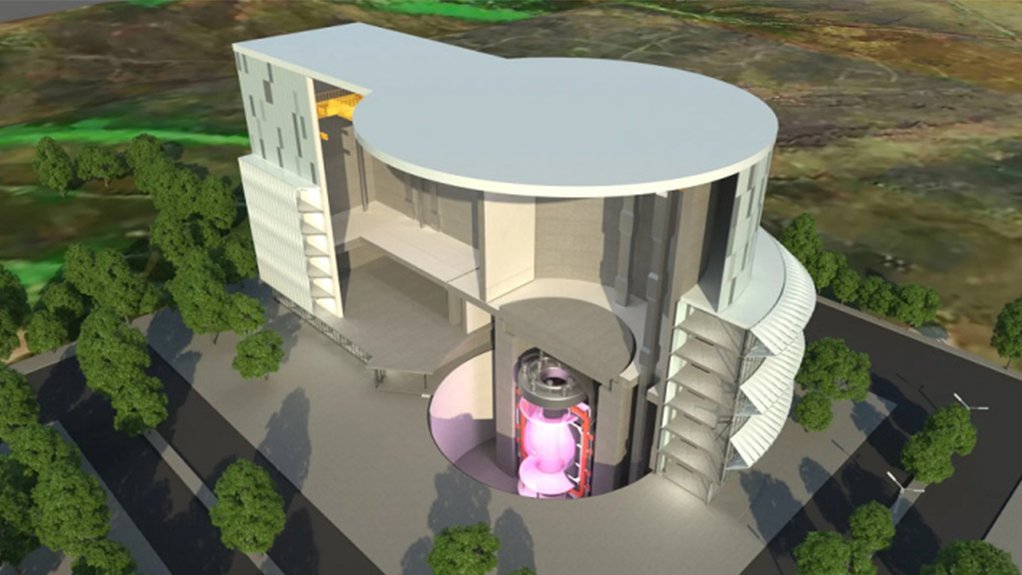UK atomic agency selects engineering consortium to help deliver nuclear fusion project


An artist’s cutaway impression of the STEP facility, showing the spherical torus
Photo by UKAEA
The UK Atomic Energy Authority (UKAEA), which is that country’s agency for the development of nuclear fusion power, has selected a consortium, led by design, engineering and project management consultancy Atkins (part of Canada’s multinational SNC-Lavalin group) as prime contractor, to be its engineering delivery partner for its Spherical Tokamak for Energy Production (STEP) programme.
In this endeavor, Atkins is partnered with its frequent collaborator, France-based international engineering services group Assystem. The other members of the consortium are British company Oxford Sigma, which specialises in In-Vessel Component materials technology and safety for nuclear fusion plants, Japanese specialist In-Vessel Component and Tritium company Kyoto Fusioneering, and Ansaldo Nuclear (the UK subsidiary of the Italian Ansaldo Energia group).
The form of nuclear energy currently widely used around the world today is nuclear fission, which generates energy by splitting atoms. Nuclear fusion generates energy by fusing atoms together. Fusion is the process which powers the Sun and all other stars. With fusion, one kilogramme of fuel (a gas composed of the hydrogen isotopes of deuterium and tritium) would produce the same amount of energy as ten million kilogrammes of fossil fuel. In addition to producing huge amounts of energy and being zero-carbon, it would result in very little radioactive waste (the process produces no radioactive byproducts; only reactor components become radioactive). It is seen to be the ultimate form of energy.
But it is incredibly difficult to achieve. The hydrogen gas fuel has to be heated to more than 100-million degrees Celsius, becoming a plasma. That incredibly hot plasma has to be controlled, generally by using powerful magnets arrayed around the ‘reaction chamber’. The fusion reaction takes place within the plasma, creating helium nuclei (helium being an inert gas) and neutrons.
STEP is a technology demonstrator programme. Most fusion projects so far have focused on using a ring doughnut-shaped reaction chamber, known as a torus or a tokamak. STEP will use a torus/tokamak shaped like an apple whose core has been removed. This would increase the efficiency of the magnetic field controlling the plasma and could reduce the cost of the plant.
“Fusion has great potential to deliver safe, sustainable, low carbon energy for generations to come, and STEP is leading the way,” affirmed UKAEA STEP commercial and programme development head Tristram Denton. “It’s an ambitious programme operating at the forefront of science, technology and engineering. It’s clear we must make significant changes to address the effects of climate change, and STEP’s delivery partners will play a crucial role in our quest to making fusion a reality.”
“The commercialisation of fusion energy holds the key to unlocking an abundant source of safe, clean energy that will power a net zero future, and the ambitious STEP programme positions the UK as a global leader in such highly complex projects,” highlighted Atkins Europe, Middle East and Africa Nuclear and Power MD Christophe Junillon. “A viable, investible concept design is central to UKAEA’s ambitions and Atkins is proud to extend our involvement in STEP’s development through this consortium.”
The UKAEA seeks to develop a concept design for STEP by 2024, for which work the UK government has budgeted £220-million. This would be followed, in Phase 2 of the project, by the development of a detailed engineering design, leading to Phase 3, the actual construction of the prototype STEP fusion power plant. Completion of this plant is currently targeted for around 2040. This prototype fusion plant would be commercial-scale and would feed energy into the UK national grid but it would not operate commercially – at least, not at first.
The UK is also a member of the international ITER fusion project, which will be the world’s largest nuclear fusion experiment. The ITER plant is currently being built in France and will use a conventional tokamak. ITER is currently scheduled to start operating in December 2025.
Comments
Announcements
What's On
Subscribe to improve your user experience...
Option 1 (equivalent of R125 a month):
Receive a weekly copy of Creamer Media's Engineering News & Mining Weekly magazine
(print copy for those in South Africa and e-magazine for those outside of South Africa)
Receive daily email newsletters
Access to full search results
Access archive of magazine back copies
Access to Projects in Progress
Access to ONE Research Report of your choice in PDF format
Option 2 (equivalent of R375 a month):
All benefits from Option 1
PLUS
Access to Creamer Media's Research Channel Africa for ALL Research Reports, in PDF format, on various industrial and mining sectors
including Electricity; Water; Energy Transition; Hydrogen; Roads, Rail and Ports; Coal; Gold; Platinum; Battery Metals; etc.
Already a subscriber?
Forgotten your password?
Receive weekly copy of Creamer Media's Engineering News & Mining Weekly magazine (print copy for those in South Africa and e-magazine for those outside of South Africa)
➕
Recieve daily email newsletters
➕
Access to full search results
➕
Access archive of magazine back copies
➕
Access to Projects in Progress
➕
Access to ONE Research Report of your choice in PDF format
RESEARCH CHANNEL AFRICA
R4500 (equivalent of R375 a month)
SUBSCRIBEAll benefits from Option 1
➕
Access to Creamer Media's Research Channel Africa for ALL Research Reports on various industrial and mining sectors, in PDF format, including on:
Electricity
➕
Water
➕
Energy Transition
➕
Hydrogen
➕
Roads, Rail and Ports
➕
Coal
➕
Gold
➕
Platinum
➕
Battery Metals
➕
etc.
Receive all benefits from Option 1 or Option 2 delivered to numerous people at your company
➕
Multiple User names and Passwords for simultaneous log-ins
➕
Intranet integration access to all in your organisation



















